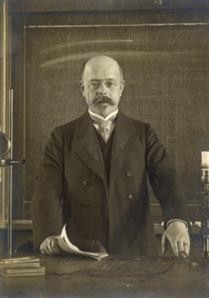Walther Hermann Nernst (1864-1941)
 Walther Hermann Nernst was born in Briesen, West Prussia, on June 25,
1864. His father, Gustav Nernst, was a district judge. He spent his early
school years (Gymnasium) at Graudentz, and subsequently went to the Universities
of Zurich, Berlin and Graz (Ludwig Boltzmann and Albert von Ettinghausen), studying
physics and mathematics.
Walther Hermann Nernst was born in Briesen, West Prussia, on June 25,
1864. His father, Gustav Nernst, was a district judge. He spent his early
school years (Gymnasium) at Graudentz, and subsequently went to the Universities
of Zurich, Berlin and Graz (Ludwig Boltzmann and Albert von Ettinghausen), studying
physics and mathematics.
At Graz, he worked with von Ettinghausen, with whom he published work in 1886 which formed part of the experimental foundation of the modern electronic theory of metals. He took his Ph.D. at Würzburg (Friedrich Kohlrausch), beginning his career as a physicist. He graduated in 1887 with a thesis on electromotive forces produced by magnetism in heated metal plates.
Nernst and corrosion monitoring
Nernst's first outstanding work was his theory of the electromotive force of the voltaic cell (1888). He developed methods for measuring dielectric constants and was the first to show that solvents of high dielectric constants promote the ionization of substances. Nernst proposed the theory of solubility product, generalized the distribution law, and offered a theory of heterogeneous reactions.
Nernst joined Wilhelm Ostwald at Leipzig University, where van't Hoff and Arrhenius were already established, and it was in this distinguished company of physical chemists that Nernst began his important researches. In 1889 he elucidated the theory of galvanic cells by assuming an "electrolytic pressure of dissolution" which forces ions from electrodes into solution and which was opposed to the osmotic pressure of the dissolved ions. In the same year he derived equations which defined the conditions by which solids precipitate from saturated solutions.
Nernst applied the principles of thermodynamics to the chemical reactions proceeding in a battery. In 1889, he showed how the characteristics of the current produced could be used to calculate the free energy change in the chemical reaction producing the current. Nernst first explained the ionization of certain substances when dissolved in water. He constructed an equation, known as the Nernst Equation, which related the voltage of a cell to its properties. This equation has also very important biophysical implementations. Independently of Thomson, he explained why compounds ionize easily in water. The explanation, called the Nernst-Thomson rule, holds that it is difficult for charged ions to attract each other through insulating water molecules, so they dissociate.
In 1905, he was appointed Professor of physical chemistry in the University of Berlin. His heat theorem, known as the Third Law of Thermodynamics, was developed in 1906. Nernst and his students in Berlin proceeded to make many important physicochemical measurements, particularly determinations of specific heats of solids at very low temperatures and of vapor densities at high temperatures. All these were considered from the point of view of quantum theory. In 1914 Walther Hermann Nernst and Max Planck succeeded in bringing Albert Einstein to Berlin. (reference)

Connect with us
Contact us today